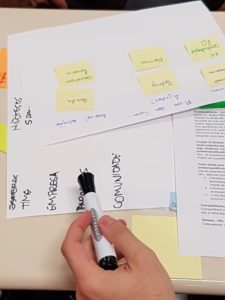by Yoris Linhares
“The people here are paid to work, not to learn.” Maybe you don’t hear it at your work (lucky you) but that is something easy to hear inside some organisations where there is a mindset of dividing thinking people (managers) from executing people (workers).
However, in twenty-first century market dynamics, there is no way anymore to separate learning from working. Continuous learning and its respective implementation to generate desired business outcomes is at the core of successful organizations. Plus, creative workers are running many tasks in actual organisations, therefore, for them, learning is the main process to their work. Although creative workers are experiencing many changes in their work, the way that creative workers learn still hasn’t evolved much.
At Agile Brazil 2016 I ran a hands-on session aimed to show that a change in the way people learn while performing their work is not a matter that takes up a lot of time, needs an expert, requires special skills, only highlights positive experiences, or avoids new ideas.
We began with them self-organizing into groups of up to five people. After that, I asked them to remember problems or difficulties that each one, along with their teammates or colleagues, had or still needed to overcome. It could include any situation like performing a task, solving a business problem, or making a decision. The goal of each group was to learn enough to create a learning tool to help them with that “learn problem” while performing their work.
To do this, they used the Learning 3.0 Flow:
- Problematization: the construction of knowledge is built on a base of a problem or challenge from the real world
- Sense-making: which gives meaning to the organised material or results that will collide with your real world. The most common practices in this process are research, connection, and practice.
- Sharing: The learning cycle is complete only after sharing the knowledge that has been built.

They came up with more specific common problems they realized they needed to learn while doing their jobs They were often complex situations in which there was a need of their own judgment and of other people. Then, they shared experiences — negative or positive — of a tool — technique, game, canvas, method — that each one had already used to solve one or more problems listed.
They also started collecting ideas from the group to create their own learning tool. Some ideas were related with experiences already shared or new ones. Later, each group transformed its ideas into a brand new learning tool that implemented the Learning 3.0 flow, the only constraint I put to them. Each group created its own learning tool using material like paper, sticky note and pen. At the end of the session, they shared among groups what they had done. They could see how the tools worked and collected feedback to improve their learning tools.
They did all this, by themselves, within 100 minutes! There was not an expert in learning tools in that session and for many, if not all, it was the first time they had created a learning tool — even a tool to use at work — by sharing experiences and new ideas.
Now, they have the basics to use the Learning 3.0 Flow to learn anytime, anywhere and about any subject they face at their work. And still more, they have at hand a useful tool to help them learn while performing their work.
The main point was not to learn about an new learning system — Learning 3.0 — but rather to realize that when creative workers intelligently put learning as the centerpiece of their work, they can enjoy the benefits of it without loss of efficiency and making their work more efficient. So, to create a culture of continuous learning for individuals, teams and hence an organization, you need to incorporate learning into your working processes and drive people to learn by doing.
Want to share the learning tool you came up with? Comment below and share your experiment!

